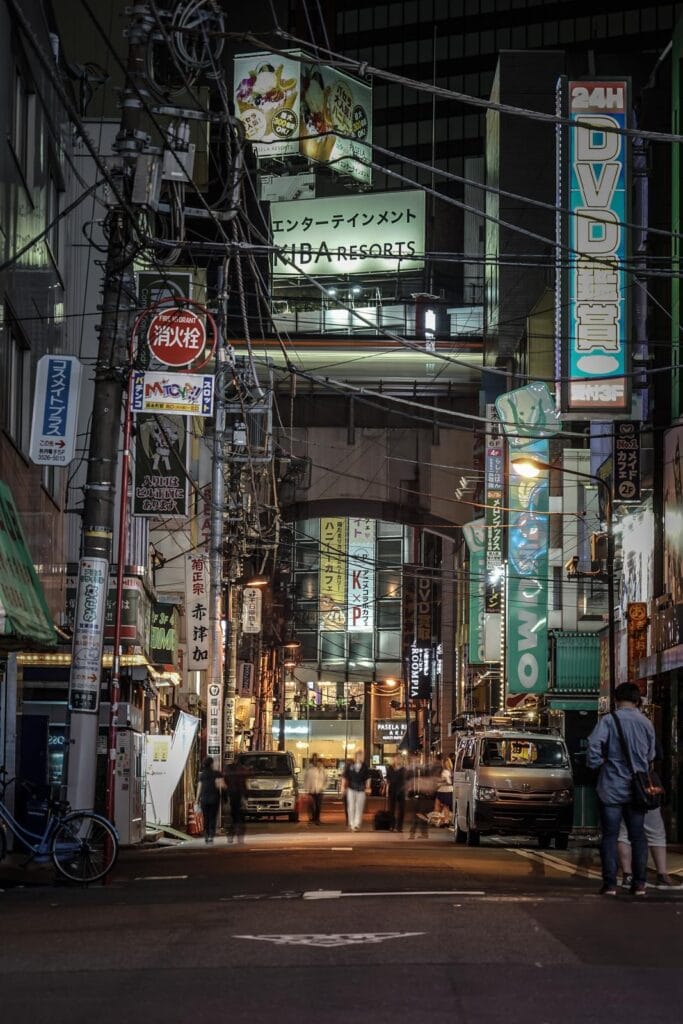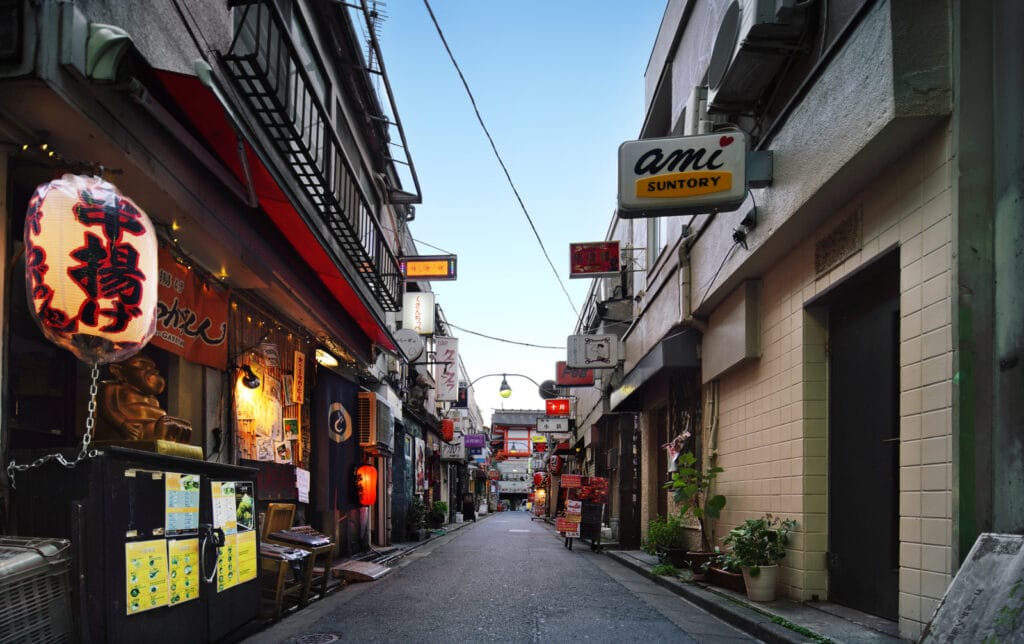Japan’s most iconic anime locations offer an unforgettable journey through your favorite series.
I’ve explored the bustling Shibuya Crossing, where modern Tokyo pulses with energy, and wandered through the whimsical Ghibli Museum, where Miyazaki’s magic comes to life.
You won’t want to miss Akihabara’s vibrant otaku culture, the serene pilgrimage sites of “Your Name” in Hida-Furukawa, or the enchanting Dogo Onsen that inspired “Spirited Away.”
The nostalgic streets of Azabu-Juban bring Sailor Moon‘s world to reality, while Shinjuku’s neon-lit alleys capture Tokyo Ghoul’s atmospheric essence.
Each destination holds secrets that’ll transform your anime dreams into tangible memories.
1) The Iconic Shibuya Crossing
I love telling visitors that this isn’t just any intersection – it’s a masterpiece of urban design that’s evolved since the 1940s.
Just like Tokyo’s ramen culture, the crossing has become an essential part of the city’s identity, drawing crowds day and night.
When the crossing signal turns green, you’ll join thousands of people in a mesmerizing dance across multiple directions, including the famous diagonal paths.
If you’re an anime fan, you’ll feel like you’re stepping right into your favorite series while experiencing this unique blend of modern innovation and pop culture significance that perfectly captures Tokyo’s spirit.
For a similar bustling energy in Osaka, head to Dotonbori district, where the dazzling neon lights and vibrant street life create an equally cinematic atmosphere.
2) Ghibli Museum Magic
Tucked away in Tokyo’s western suburb of Mitaka, the Ghibli Museum stands as a whimsical tribute to the magic of Studio Ghibli’s animation.
I’ll tell you right now – you’ll need to plan ahead since tickets must be purchased in advance through Lawson stores in Japan or select travel agencies abroad.
Once inside, you’re free to wander through the museum’s enchanting maze-like interior, where Hayao Miyazaki’s architectural vision comes to life.
You’ll discover a fascinating animation studio mock-up, a mesmerizing zoetrope with beloved Ghibli characters, and exclusive short films in the cozy theater.
Taking the Chuo Line from major transit hubs like Shinjuku Station provides convenient access to the museum within 20 minutes.
Don’t miss the rooftop garden, where a life-sized robot from “Castle in the Sky” keeps watch over visitors, or the delightful Straw Hat Cafe when you need a break from exploring.
As with many popular attractions in Japan, first-time visitors should consider booking their museum tickets at least three months before their planned visit date.
3) Hidden Gems of Akihabara

While Studio Ghibli captures the fantasy of anime, Akihabara brings it into reality. I’ve discovered countless hidden treasures in this electric town, where anime culture pulses through every neon-lit street and back alley.
You’ll find my three favorite spots tucked away from the main strips, each offering unique collectibles you won’t spot in tourist guides.
For collectors seeking an alternative, Den Den Town offers a similar anime shopping experience in Osaka’s Nipponbashi district.
| Store Name | Hidden Specialty | Best Time to Visit |
|---|---|---|
| AmiAmi | Pre-order exclusives | Early morning |
| Mandarake | Vintage treasures | Weekday afternoons |
| Kotobukiya | Limited editions | Weekend openings |
| Yellow Submarine | Rare trading cards | Late evening |
| Toranoana | Indie merchandise | Mid-afternoon |
Beyond these gems, don’t miss the upper floors of Radio Kaikan, where you’ll uncover rare figures and exclusive merchandise that’ll make any collector’s heart skip a beat.
Visiting these shops during off-peak hours can help you stay within your travel budget while avoiding the crowds.
4) Hida-Furukawa’s Your Name Pilgrimage
Following the enchanting story of “Your Name,” anime fans have made Hida-Furukawa their must-visit pilgrimage site in Japan.
I’ll guide you through this charming town where reality and anime beautifully intertwine, starting at the Hida-Furukawa JR Station with its adorable Hida-gyu mascot welcoming visitors.
You’ll want to capture the perfect shot at the nearby crossover bridge, especially stunning in winter’s snowy embrace, before heading to Ajidokoro Furukawa Restaurant for authentic gohei mochi – just like the characters enjoyed.
Don’t miss climbing the iconic stairs at Keta Wakamiya Shrine, where Taki’s memorable scene was set.
Enhance your journey with a stay at Mount Fuji ryokans offering spectacular views of Japan’s most iconic peak.
I recommend staying at the Hida Tomoe Hotel, just five minutes from the station, where you can soak in mineral baths after a day of exploration.
For those seeking the ultimate Japanese experience, combine your anime pilgrimage with a visit to luxury ryokans nearby for traditional hospitality.
5) Spirited Away’s Dogo Onsen

From the mountain town of Hida-Furukawa, let’s head south to another iconic anime location: Dōgo Onsen, the centuries-old bathhouse that inspired Hayao Miyazaki’s masterpiece “Spirited Away.”
This architectural marvel, built in 1894, captivates visitors with its intricate wooden design and maze-like interior of stairways and passages.
When you visit, you’ll discover why this enchanting bathhouse sparked Miyazaki’s imagination.
Like Kyoto’s temple-style shojin ryori, the bathhouse preserves ancient Japanese cultural traditions through its authentic architecture and ritualistic bathing practices.
The bathhouse’s subtropical location provides a warm, humid atmosphere year-round that adds to its mystical appeal.
Here’s what you can’t miss:
- Two traditional public baths: Kami no Yu and Tama no Yu
- The exclusive Yushinden bath, built for the Imperial Family
- Atmospheric tatami rooms for post-bath relaxation
- The charming Botchan Karakuri Clock outside
- Local visitors strolling in traditional yukata robes
I recommend visiting during off-peak hours to fully appreciate the spiritual ambiance that inspired Yubaba’s mystical bathhouse in the film.
6) Sailor Moon’s Azabu-Juban District
Streets brimming with nostalgia welcome fans to Tokyo’s Azabu-Juban district, the real-life setting that inspired Naoko Takeuchi’s beloved manga and anime series “Sailor Moon.”
This upscale neighborhood in Minato ward perfectly captures the essence of Usagi Tsukino’s magical world, with its charming mix of traditional shops, narrow cobblestone streets, and modern boutiques.
Like Osaka’s family-friendly attractions, this district offers activities suitable for visitors of all ages.
| Must-See Locations | Best Time to Visit | Fan Experience |
|---|---|---|
| Azabu Hikawa Shrine | Early Morning | Photo ops with shrine details |
| Crown Game Center | Afternoon | Retro gaming atmosphere |
| Arisugawa Park | Sunset | Chibiusa’s time-travel spot |
You’ll find yourself transported into Sailor Moon’s world at the annual Noryo Festival in August, where food stalls and performances create a magical atmosphere.
Don’t miss the uniquely designed McDonald’s or the beloved Kimichan statue, which have become unofficial pilgrimage spots for devoted fans.
For seamless navigation through the district, consider downloading essential travel apps that provide offline maps and real-time transit information.
7) Tokyo Ghoul’s Shinjuku Streets

The haunting world of Tokyo Ghoul comes alive in Shinjuku’s neon-lit streets, where Ken Kaneki’s transformation from human to ghoul unfolded.
Similar to the easy train access to Hakone from Tokyo, visiting Shinjuku is straightforward and convenient.
I’ve found that visiting during sunset creates the perfect atmosphere to experience this iconic anime location, especially around the bustling Kabukicho area.
As you explore Shinjuku’s atmospheric streets, you’ll discover several key locations from the series:
- Shinjuku Station’s East Exit, where Ken and Touka’s memorable meetings took place
- The vibrant Kabukicho Crossing, central to Kaneki’s ghoul transformation scenes
- The famous peeping Godzilla head, a perfect photo opportunity
- Countless izakayas and restaurants that mirror the show’s settings
- The atmospheric street scenes that come alive with neon lights after dark
The area perfectly captures Tokyo Ghoul’s dark urban essence, making it an essential stop for any anime pilgrim.
Getting here is convenient as Shinjuku Station serves as a major transportation hub connecting multiple subway and railway lines throughout the city.




